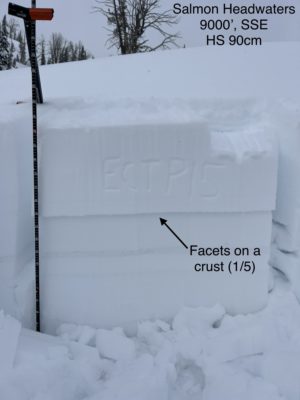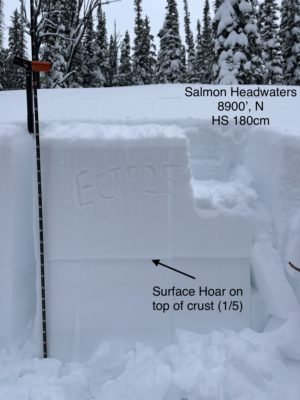Basic Information
Observation Details
Observation Date:
January 19, 2023Submitted:
January 19, 2023Observer:
SAC - Jon PreussZone or Region:
Sawtooth and Western Smoky MtnsLocation:
Salmon Headwaters (All aspects; 7300-9600')Signs of Unstable Snow
Recent Avalanches?
None ObservedCracking?
None ExperiencedCollapsing?
None ExperiencedBottom Line
A thin rain crust exists on all aspects of this area (observed to 9600'). It is buried about 1.5 feet beneath the surface. Most stability tests showed results above this layer. The sunny slopes have a layer of facets, while the shady aspects have buried surface hoar.
Media/Attachments


Advanced Information
Weather Summary
Cloud Cover:
ObscuredWind:
Light , NWNew/Recent Snowfall:
HN: 4-6cmThe morning hours had broken skies with some sunlight coming through. Light snow (S-1) continued for the remainder of the day. Winds were variable. The winds were more SE in the morning. They were out of the NW in the upper elevation during the afternoon.
Avalanche Observations
There was some wet loose (D1) from over the weekend in steep SE-facing terrain. Today, I observed some dry loose in the new/old snow in slopes greater than 40*.
There were numerous tracks (snowmobile and/or snowbikes) on slopes over 30 degress with no associated avalanches.
Snowpack Observations
Today I dug 4 different snow pits on north-facing slopes (8400-9000'; N-NE; HS 157-180cm). The goal was to track the distribution and character of the weak layer in the upper snowpack (1/5). All of my snowpits (north facing) had a layer of buried surface hoar sitting on top of a thin rain crust. The layer was buried 1.5 feet (45-50 cm) down below the surface. The size of the surface hoar varied from location to location. The snowpits with larger surface hoar (3-5mm) were the only propagating results (ECTP25). I performed 3 ECTs in each snowpit, and I received ECTN in the hard (20-30 hits) range within all but one test (ECTP25). I didn't test layers or dig down to the ground on the north-facing pits.
The south-facing snowpit (see below) had a thin layer of facets (1-2mm) above the rain crust (1/5). I got multiple propagating results (ECTP15 x 3) on the layer of facets. There was a subtle layer of surface hoar a couple of inches (6cm) above the facets, but appeared to be melted. The overlaying slab above 1/5 was fist to 4finger hardness.


Avalanche Problems
| Problem | Location | Distribution | Sensitivity | Size | Comments |
|---|---|---|---|---|---|
 Persistent Slab
Persistent Slab
|
|
Layer Depth/Date: 35-50cm/0105 Weak Layer(s): Jan 5, 2023 (SH) Comments: Shading reflects where snowpits produced results. |
Today's findings support the "spotty" distribution of the surface hoar. Most of the surface hoar was small in size in this location. It might take finding the right crop of surface hoar--larger, upright feathers--to cause unstable conditions.
Terrain Use
Solo travel. Avoided skiing avalanche terrain.
